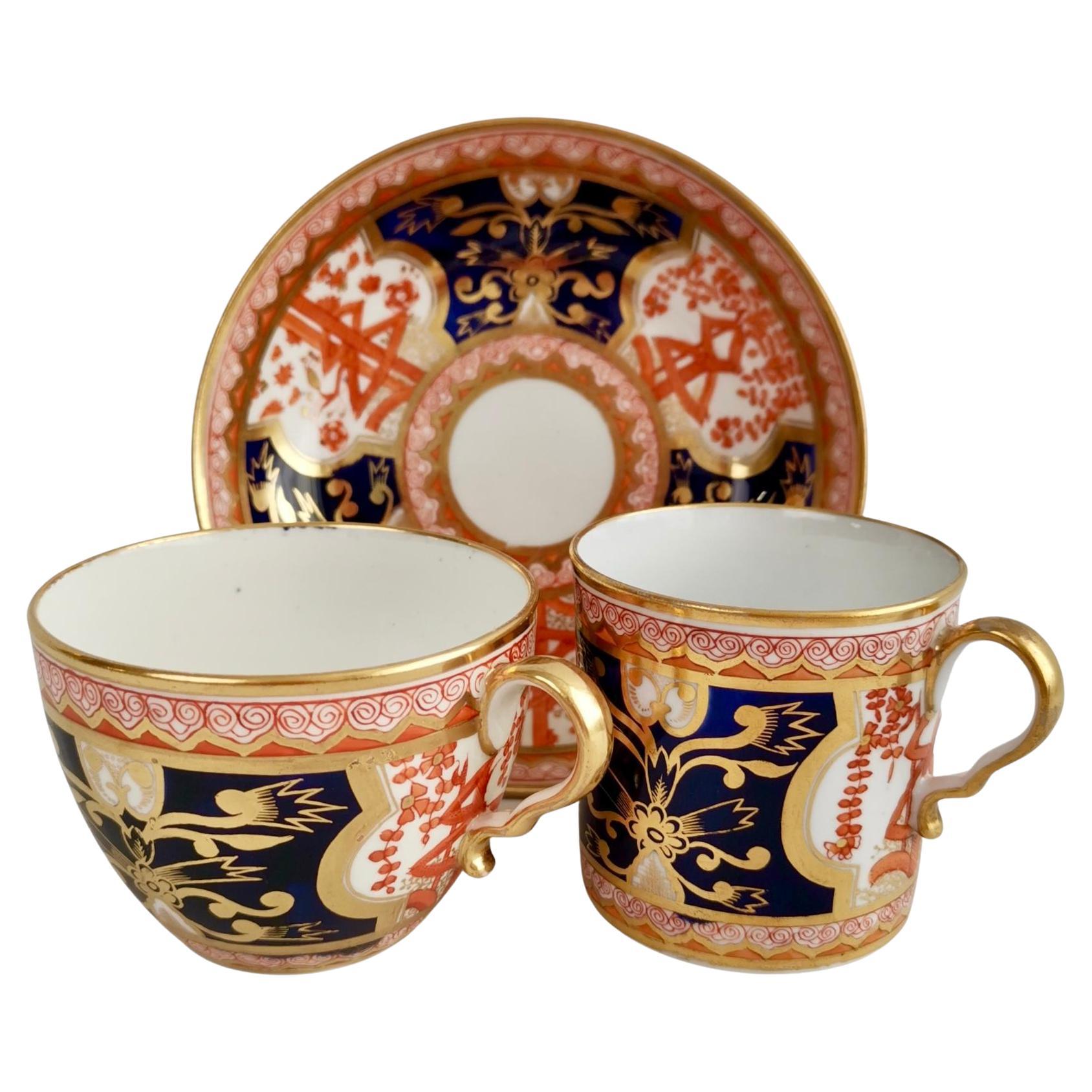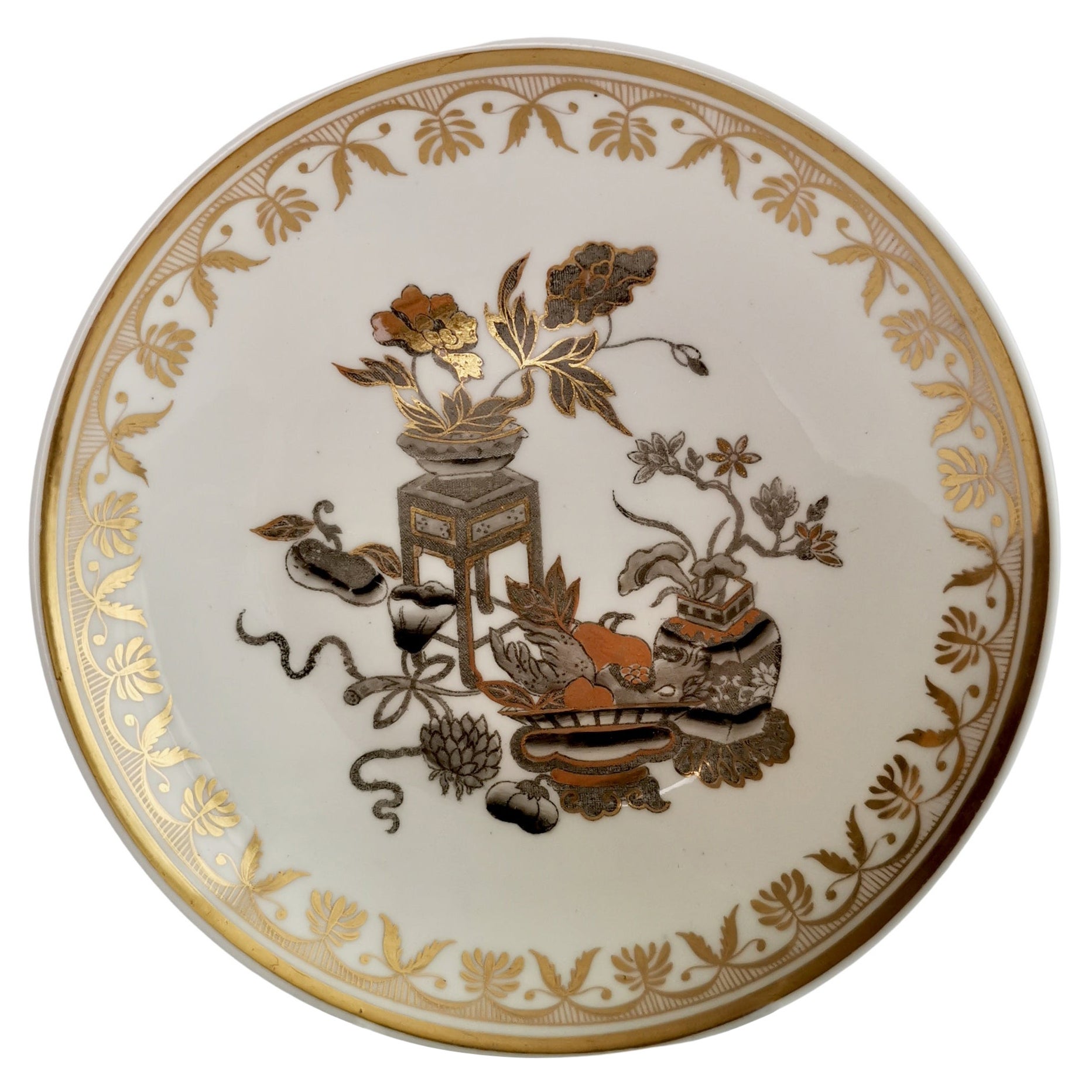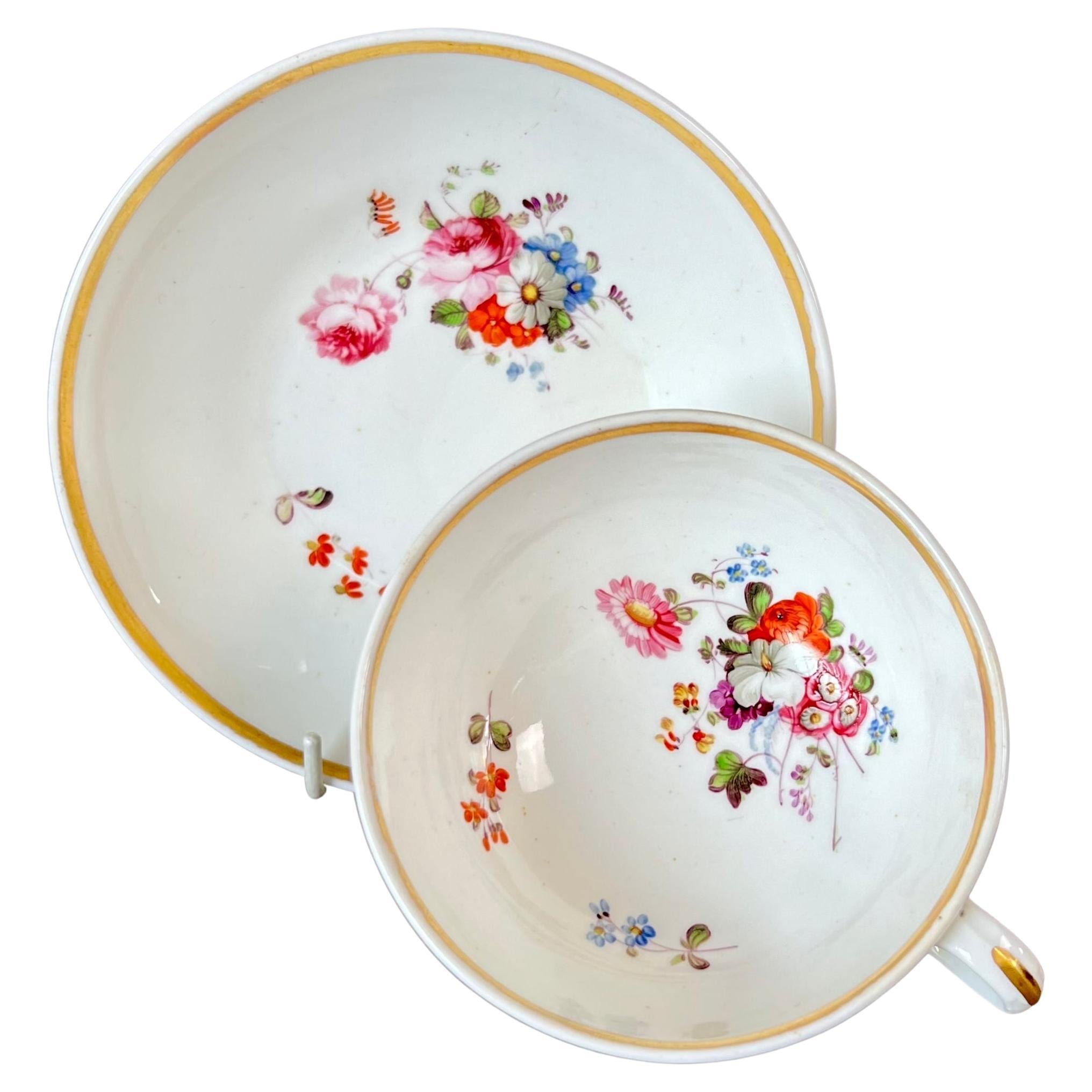Spode Porcelain Teacup Trio, Lavender Blue with Flower Sprays, Regency ca 1815
About the Item
- Creator:Spode (Maker)
- Dimensions:Height: 1 in (2.54 cm)Width: 1 in (2.54 cm)Depth: 1 in (2.54 cm)
- Sold As:Set of 3
- Style:Regency (Of the Period)
- Materials and Techniques:
- Place of Origin:
- Period:
- Date of Manufacture:circa 1815
- Condition:Wear consistent with age and use. In perfect antique condition without any damage, crazing or repairs and only minimal wear as visible in the pictures.
- Seller Location:London, GB
- Reference Number:
Spode
Spode is one of the oldest and most distinguished of the great pottery companies of Staffordshire, the time-honored home of English ceramics. The firm’s blue and white bone china transferware is a timeless classic. Spode dishes compose the sort of elegant dinner service that most of us envision on a traditional holiday table.
The company was established in 1770 in Stoke-on-Trent by Josiah Spode, a friend and neighbor of another estimable English ceramist, Josiah Wedgwood. Spode was particularly known for two technical achievements in the firm’s early decades. The first was to develop a standard formula for the making of bone china — a type of porcelain (made with a mixture of bone ash, minerals and clay) that is dazzlingly white and so strong it can be used to create very thin translucent plates and vessels. The other was to perfect the making of transferware. That process involves the transfer of pictorial images inked on tissue paper — such as the garden scenery in the famous Willow dish patterns — onto ceramics that are then sealed with a glaze. In 1833, following the sudden death of Josiah Spode III, business partner W.T. Copeland took over the company and changed its name. Collectors regard Copeland-marked pieces as Spode china. The Spode brand was revived in 1970.
From the 1820s onward, Spode enjoyed tremendous success both in Britain and elsewhere owing to the beauty and vitality of its decorative imagery. By some counts, Spode created more than 40,000 patterns in the 19th century. Many favorite Spode patterns — among them Blue Italian, India Tree, Greek and Woodland — date to the company’s early years. Spode’s most popular pattern, Christmas Tree, was introduced in 1938. Prices for Spode china vary widely, based on the size of the service, its condition and the pattern. An antique dinner service for 12 people or more, in good repair and complete with cups and serving dishes, will generally cost between $10,000 and $20,000. Such Spode services become heirlooms — a proud and timeless addition to a family’s table. And as you will see on these pages, Spode’s rich and varied wares offer a visual feast in and of themselves.
- ShippingRetrieving quote...Ships From: London, United Kingdom
- Return PolicyA return for this item may be initiated within 14 days of delivery.
- Spode Porcelain Teacup Trio, Red Imari Dollar Pattern, Regency, ca 1810By SpodeLocated in London, GBThis is a beautiful orphaned teacup made by Spode in about 1810. It bears a beautiful Japanese-inspired Imari pattern. Spode was the great pioneer among the Georgian potters in England. Around the year 1800 he perfected the bone china recipe that has been used by British potters ever since, and he was also the leading potter behind the technique of transferware, making it possible for English potters to replace the Chinese export china, which had come to an end around that time, with their own designs. This was fundamental to a thriving industry that would last for about 150 years and provide half the world with their tableware. Spode porcelain is regarded as one of the highest quality porcelains around; for a soft-paste porcelain it is surprisingly hard and fine, and has a wonderful bright white colour. The pattern on this can is called "Dollar" pattern, a very famous pattern that was used by English potters in the 18th and early 19th Century. It is obvious why it is called “dollar” - but its origin is less obvious! It is thought that this pattern was derived from a very old Chinese pattern depicting a tree with elaborate foliage that hides a Chinese character representing longevity or happiness. Traditionally, this went with a an image called “Taotie”, which was used on very ancient bronze vases...Category
Antique Early 1800s English Regency Porcelain
MaterialsPorcelain
- Spode Porcelain Teacup, Imari Tobacco Leaf Pattern 967, Regency ca 1810By SpodeLocated in London, GBThis is a beautiful teacup and saucer made by Spode in about 1810. The set is decorated with the famous Imari Tobacco Leaf pattern 967, which was first introduced by Spode in 1806. ...Category
Antique 1810s English Regency Porcelain
MaterialsPorcelain
- Spode Teacup and Saucer, Red, Gilt with White Chrysanthemum, Regency ca 1810By SpodeLocated in London, GBThis is a beautiful teacup and saucer made by Spode around 1810. The set is shaped in the "bute" shape and decorated with a bright Neoclassical pattern of a warm red ground with gilt...Category
Antique 1810s English Regency Porcelain
MaterialsPorcelain
- Samuel Alcock Porcelain Teacup, White with Flower Sprays, ca 1823By Samuel Alcock & Co.Located in London, GBA teacup and saucer in the “half orange” shape, white with simple gilt rim and beautiful hand painted flower sprays Pattern unknown but similar to 1082 Year: ca 1823 Size: cup diameter 10cm (4”), saucer diameter 14.2cm (5.5”) Condition: excellent, some rubbing to gilt There are several items available in this design, please see group image and ask for more info if interested. The Samuel Alcock factory was operative in Staffordshire between 1822 and 1856, after which it was bought by Sir James Duke and Nephews. The factory started as a partnership between the young Samuel Alcock and the older Ralph Stevenson, who provided the factory and capital. Alcock quickly took the factory to great heights, building one of the biggest factories of its time. Alcock jumped on the new Rococo Revival fashion and served a huge new middle class market. The reason we now don't hear much about Samuel Alcock porcelain...Category
Antique 1820s English Regency Tea Sets
MaterialsPorcelain
- Spode Orphaned Porcelain Saucer, Chinoiserie Gilt Potted Flowers, Regency ca1820By SpodeLocated in London, GBThis is a beautiful deep orphaned saucer made by Spode around 1820. The saucer is decorated with a gorgeous Chinoiserie pattern of a group of potted flowers in gilt and grey. The sau...Category
Antique 1820s English Regency Porcelain
MaterialsPorcelain
- Ridgway Porcelain Teacup and Saucer, Blue Flowers and Gilt, Regency, Ca 1825By Ridgway PorcelainLocated in London, GBThis is a beautiful teacup and saucer made around 1825 by Ridgway. It is decorated with the very popular pattern no. 2/1000: a cobalt blue ground with rich gilding and monochrome blu...Category
Antique 1820s English Regency Tea Sets
MaterialsPorcelain
- Set of Six Porcelain Bird Teacup TriosBy Flight, Barr & Barr WorcesterLocated in New York, NYSet of six porcelain bird teacup trios. Strikingly modern looking antique set of six BFB Worcester trios of six teacups and six coffee cups with six sh...Category
Antique Late 18th Century English Empire Tea Sets
MaterialsPorcelain
- Antique Meissen Porcelain Tea Tray with Cobalt Blue Border & Spray FlowersBy Meissen PorcelainLocated in Philadelphia, PAA fine antique porcelain tea tray or serving platter. By Meissen. With a scalloped rim and a rich cobalt blue border. There are hand paint...Category
20th Century German Tea Sets
MaterialsPorcelain
- Antique Early 19th Century Spode Porcelain Pattern Number 2408 Tea Cup & SaucerBy SpodeLocated in Philadelphia, PAA fine antique Spode porcelain cup & saucer. Pattern no. 2408 Decorated throughout with a cobalt floral patttern and extensive gilding. Simply a great cup & saucer from Spod...Category
Antique Early 19th Century English Neoclassical Porcelain
MaterialsPorcelain
- Bjørn Wiinblad for Rosenthal, 11 Romanze Blue Flower Teacups with Saucers, 1960sLocated in Copenhagen, DKBjørn Wiinblad for Rosenthal. 11 Romanze blue flower teacups with saucers. 1960s. The cup measures: 10.7 x 5.5 cm. Saucer diameter: 15.5 cm. In excellent condition. Stamped.Category
Vintage 1960s German Porcelain
MaterialsPorcelain
- Bjørn Wiinblad for Rosenthal, Lotus Porcelain Service, 9 Teacups with SaucersLocated in Copenhagen, DKBjørn Wiinblad for Rosenthal. Lotus porcelain service. 9 teacups with saucers decorated with pink lotus leaves. 1980s. The cup measures: 10 x 5 c...Category
Vintage 1980s German Modern Porcelain
MaterialsPorcelain
- Four Antique Meissen Teacups with Saucers in Hand-Painted PorcelainLocated in Copenhagen, DKFour antique Meissen teacups with saucers in hand-painted porcelain. Purple flowers and gold decoration. Museum quality, approx. 1740. The cup meas...Category
Antique 1740s German Porcelain
MaterialsPorcelain






